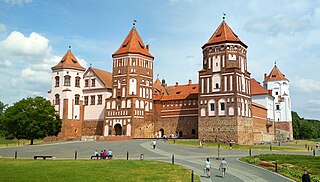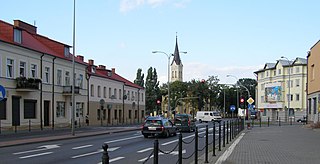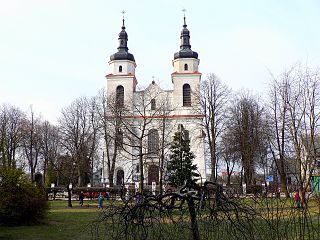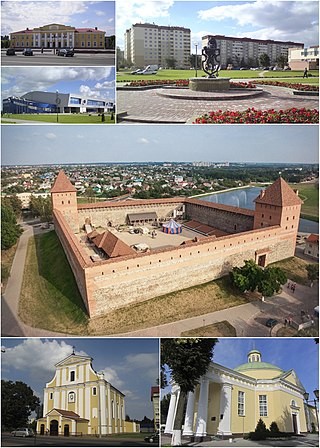
Demographic features of the population of Lithuania include population density, ethnicity, level of education, health, economic status, and religious affiliations.

Grodno or Hrodna is a city in western Belarus. It is one of the oldest cities of Belarus. The city is located on the Neman River, 300 kilometres (190 mi) from Minsk, about 15 kilometres (9.3 mi) from the border with Poland, and 30 kilometres (19 mi) from the border with Lithuania. Grodno serves as the administrative center of Grodno Region and Grodno District, though it is administratively separated from the district. As of 2024, the city has a population of 361,115 inhabitants.

Grodno region, also known as Grodno oblast or Hrodna voblasts, is one of the regions of Belarus. Its administrative center, Grodno, is the largest city in the region. As of 2024, it has a population of 992,556.

Seventeen days after the German invasion of Poland in 1939, which marked the beginning of the Second World War, the Soviet Union entered the eastern regions of Poland and annexed territories totalling 201,015 square kilometres (77,612 sq mi) with a population of 13,299,000. Inhabitants besides ethnic Poles included Belarusian and Ukrainian major population groups, and also Czechs, Lithuanians, Jews, and other minority groups.

Bielsk Podlaski is a town in eastern Poland, within Bielsk County in the Podlaskie Voivodeship. As of December 2021, the town has a population of 24,883.

Grajewo is a town in north-eastern Poland with 21,499 inhabitants (2016). It is the capital of Grajewo County within the Podlaskie Voivodeship. It is located within the historic region of Masovia, near the border with Podlachia and Masuria.

Jedwabne is a town in northeastern Poland, in Łomża County of Podlaskie Voivodeship, with 1,942 inhabitants (2002).

Lida is a city in Grodno Region, western Belarus, located 168 kilometres (104 mi) west of Minsk. It serves as the administrative center of Lida District. As of 2024, it has a population of 103,916.

The city of Vilnius, the capital of Lithuania, and its surrounding region has a long history. The Vilnius Region has been part of the Grand Duchy of Lithuania from the Lithuanian state's founding in the late Middle Ages to its destruction in 1795, i.e. five centuries. From then, the region was occupied by the Russian Empire until 1915, when the German Empire invaded it. After 1918 and throughout the Lithuanian Wars of Independence, Vilnius was disputed between the Republic of Lithuania and the Second Polish Republic. After the city was seized by the Republic of Central Lithuania with Żeligowski's Mutiny, the city was part of Poland throughout the Interwar period. Regardless, Lithuania claimed Vilnius as its capital. During World War II, the city changed hands many times, and the German occupation resulting in the destruction of Jews in Lithuania. From 1945 to 1990, Vilnius was the Lithuanian Soviet Socialist Republic's capital. From the dissolution of the Soviet Union, Vilnius has been part of Lithuania.
The city of Vilnius, the capital and largest city of Lithuania, has an extensive history starting from the Stone Age. The city has changed hands many times between Imperial and Soviet Russia, Napoleonic France, Imperial and Nazi Germany, Interwar Poland, and Lithuania.

Vilnius Region[a] is the territory in present-day Lithuania and Belarus that was originally inhabited by ethnic Baltic tribes and was a part of Lithuania proper, but came under East Slavic and Polish cultural influences over time.

Švenčionys is a city in eastern Lithuania, and capital of the Švenčionys district municipality, located 84 kilometers (52 mi) north of Vilnius. As of 2020, it had a population of 4,065 of which about 17% were part of the Polish minority in Lithuania.

Švenčionėliai is a city in Švenčionys district municipality, in eastern Lithuania 10 km west of Švenčionys. The river Žeimena flows through Švenčionėliai.

Pabradė is a city in eastern Lithuania, in Švenčionys district municipality, on the Žeimena river, 38 km south-west of Švenčionys.

According to the Lithuanian census of 2021, the predominant religion in Lithuania is Christianity, with the largest confession being that of the Catholic Church. There are smaller groups of Orthodox Christians, Evangelical Lutherans, members of Reformed churches, other Protestants, Jews and Muslims as well as people of other religions.

The Polish population transfers in 1944–1946 from the eastern half of prewar Poland, were the forced migrations of Poles toward the end and in the aftermath of World War II. These were the result of a Soviet Union policy that had been ratified by the main Allies of World War II. Similarly, the Soviet Union had enforced policies between 1939 and 1941 which targeted and expelled ethnic Poles residing in the Soviet zone of occupation following the Nazi-Soviet invasion of Poland. The second wave of expulsions resulted from the retaking of Poland from the Wehrmacht by the Red Army. The USSR took over territory for its western republics.

Ivyanyets or Ivenets is an urban-type settlement in Valozhyn District, Minsk Region, Belarus. It is located 56 kilometers (35 mi) west of Minsk. In 2017, its population was 4,206. As of 2024, it has a population of 3,848.

Dieveniškės is a town in the Vilnius County of Lithuania, about 6 kilometres (3.7 mi) from the Belarusian border in the so-called Dieveniškės appendix. It is surrounded by the Dieveniškės Regional Park.
Švenčionys, Svintsyan or Święciany Ghetto was a Jewish ghetto in Nazi-occupied Švenčionys. It operated from July 1941 to April 1943. At its peak, the ghetto housed some 1,500 prisoners. It was located in what today is a city park; the location is marked by a wooden menorah carved by Juozapas Jakštas.
The Švenčionėliai massacre was the mass murder of Jews during the Holocaust on October 8-10 1941, at the former Soviet military training ground in Žeimena forest, about 1.5km away from Švenčionėliai in Lithuania, then known as the Generalbezirk Litauen in the Reichskommissariat Ostland.





















